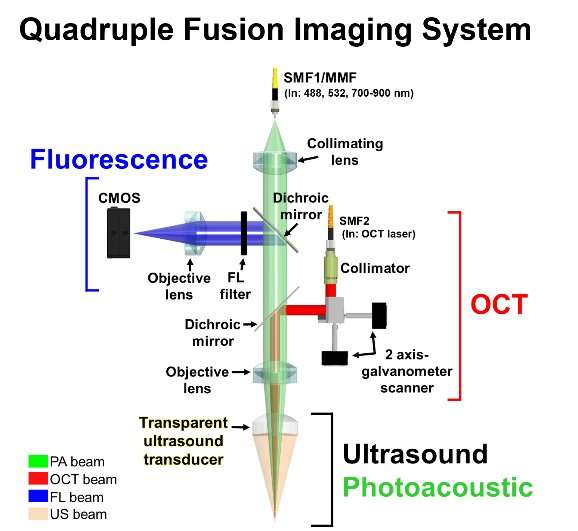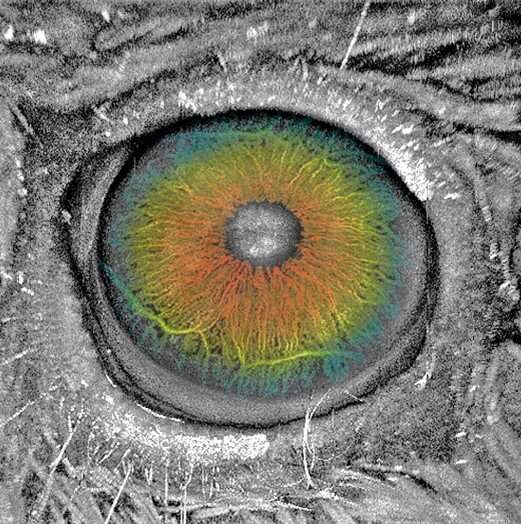A schematic diagram of a quadruple fusion imaging system developed by coaxially combining a laser and a transparent ultrasound transducer. 1) Ultrasound image, 2) Photoacoustic image, 3) Optical coherence tomography 4) Fluorescence imaging. Credit: POSTECH
A quadruple fusion optical and ultrasound imaging system has been developed that allows diagnosis of eye conditions or tumors or to see the environment inside the body using a transparent ultrasound transducer.
Professor Chulhong Kim of POSTECH's Department of Electrical Engineering, Convergence IT Engineering, and Mechanical Engineering, Dr. Byullee Park of Department of Convergence IT Engineering, Ph.D. candidate Jeongwoo Park of School of Interdisciplinary Bioscience and Bioengineering, Professor Hyung Ham Kim of Department of Convergence IT Engineering, and Professor Unyong Jeong of Department of Materials Science and Engineering, in joint research with Professor Hong Kyun Kim of Kyungpook National University School of Medicine have together developed a transparent ultrasound transducer1 and has used it to produce the world's first quadruple fusion imaging system that integrates ultrasound imaging, photoacoustic imaging, optical coherence tomography, and fluorescence imaging. These research findings were published in the Proceedings of the National Academy of Sciences (PNAS) on March 8, 2021.
There is a growing interest in multimodal imaging systems that obtain various images and information by combining ultrasound and optical imaging devices. Among them, an ultrasound transducer is a device that produces images by generating ultrasound and functions as an image sensor in ultrasonic examinations. But it was not optically transparent and difficult to let lasers pass through effectively, and therefore had limitations to be coaxially combined with an optical imaging device.
Mouse eye images taken simultaneously with photoacoustic and optical coherence imaging. Photoacoustic indicates blood vessels in the rat eye and optical coherence indicates its structure. Credit: POSTECH
To solve this issue, the research team developed a highly sensitive transparent ultrasound transducer which the laser can effectively pass through. This newly developed device obtains quadruple fusion images of ultrasound, photoacoustic, optical coherence, and fluorescence in one imaging system for the first time.
Using the quadruple fusion imaging system combined with a transparent ultrasound transducer integrated into an ophthalmic imaging system, the researchers were able to observe the corneal neovascularization, structural changes, cataracts, inflammation, and other epidemiological changes in the rat eye.
In addition, when used as a tumor imaging device, the researchers were able to multiparametrically visualize the oxygen saturation of surrounding blood vessels and tissues in a melanoma-afflicted mouse without using a contrast agent. With molecular imaging, breast cancer diagnosis is now possible as demonstrated by acquiring and observing various images of a mouse with breast cancer through injecting a contrast agent that is harmless to the human body.
These research findings are anticipated to be widely applicable to various industries where ultrasound and optical sensors are used, such as healthcare and medical fields, mobile, automobiles, robotics, non-destructive testing, as well as ophthalmological diseases and tumor imaging diagnosis.
More information: Jeongwoo Park et al, Quadruple ultrasound, photoacoustic, optical coherence, and fluorescence fusion imaging with a transparent ultrasound transducer, Proceedings of the National Academy of Sciences (2021). DOI: 10.1073/pnas.1920879118
Journal information: Proceedings of the National Academy of Sciences
Provided by Pohang University of Science & Technology (POSTECH)
























